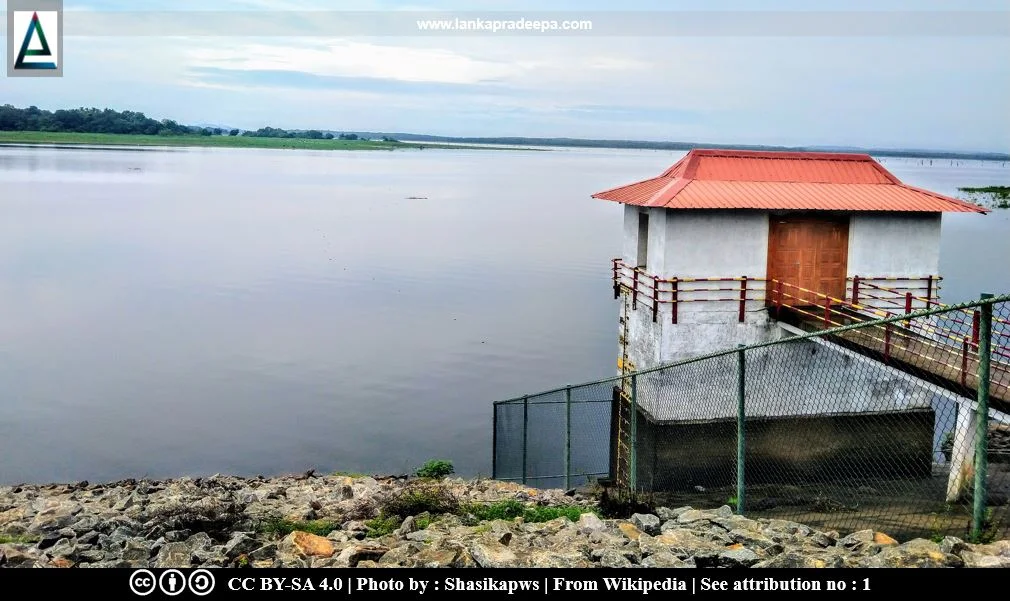
|
Padaviya Wewa |
Padaviya Wewa (Sinhala: පදවිය වැව) is a shallow man-made reservoir situated in Anuradhapura District, Sri Lanka.
History
This reservoir has been identified by scholars as the ancient Ratmalkanda Vapi of King Mahasena (277-304 A.D.) and Dhanavapi of King Moggallana II [(535-555 A.D.) Arumugam, 1969]. It was later known as Padivapi and King Parakramabahu I (1153-1186 A.D.) restored it (Arumugam, 1969; Nicholas, 1963). King Nissankamalla (1187-1196 A.D.) decreed Padivapi a sanctuary for animals (Arumugam, 1969; Nicholas, 1963).
The restoration works of the present tank were carried out in 1954-1958 (Arumugam, 1969). The tank and its surrounding area were designated as a Wildlife Sanctuary in 1963.
Inscription
A pillar inscription of King Parakramabahu I (1153-1186 A.D.) has been discovered near the sluice of the Padaviya reservoir. Although, this inscription records that this tank was built by Parakramabahu, scholars have identified him as a restorer of the tank and not the builder.
Pillar inscription at the Sluice of Padaviya Tank
Reign: Parakramabahu I (1153-1186 A.D.)
Period: 12th century A.D.
Script & Language: Medieval Sinhala
Content: This was caused to be constructed for the benefit of the whole world by the Lord of Lanka, His Majesty King Sri Parakramabahu, who intensely busied himself with fervent activity.
Reference: The information board at the site by the Department of Archaeology and the Ministry of National Heritage.
The Reservoir
The reservoir has been constructed by damming the Mora Oya and Mukunu Oya (Arumugam, 1969; Siriwardana et al., 2019). The bund of the reservoir is about 2.75 miles long and the water is extending in an area of about 5,800 acres at its full supply level (Arumugam, 1969). It has one spill and one sluice with three openings (Arumugam, 1969).

|
Padaviya Wewa inscription and other ruins |
Related Posts
Read Also
References
Books, Journal Articles
1) Arumugam, S., 1969. Water resources of Ceylon: its utilisation and development. Water Resources Board. p.276.
2) Nicholas, C. W., 1963. Historical topography of ancient and medieval Ceylon. Journal of the Ceylon Branch of the Royal Asiatic Society, New Series (Vol VI). Special Number: Colombo. Royal Asiatic Society (Ceylon Branch). pp.87,168.
3) Siriwardana, C., Cooray, A.T.,
Liyanage, S.S. and Koliyabandara, S.M.P.A., 2019. Seasonal and spatial variation of dissolved oxygen and nutrients in Padaviya Reservoir, Sri Lanka. Journal of Chemistry, 2019. pp.1-11.
Location Map
Dynamic Google Map
Attribution
To Whom
1) Padaviya tanka by Shasikapws is licensed under CC BY-SA 4.0
2) This painting (King Parakramabahu's pillar at Padaviya) which is presently housed in the British Museum under the no.1941,0419,0.1 has been released under CC BY-NC-SA 4.0.
3) LankaPradeepa.com also extends its gratitude to Mrs Badra Kamaladasa (Former Director General of Irrigation) for providing the necessary photographs required for this article. All the photos are published here with the permission of the author.


